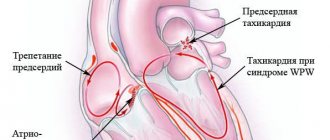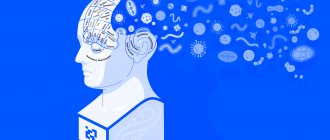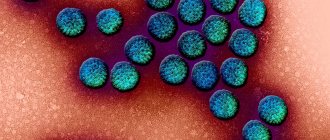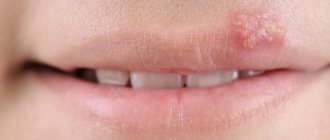Spastic colitis - what is it?
Spastic colitis is a persistent disorder of the functional state of the intestine. The pathology is accompanied by the occurrence of painful spasms. The disease does not provoke organic disorders in the organ. A characteristic manifestation of this type of colitis is a dystrophic change in the tissues of the digestive tract. The inflammatory process is less pronounced than in other forms of diseases in this category.
In women, spastic colitis is diagnosed more often than in men. The risk group also includes children (from an early age).
Why can colitis develop?
Pancreatitis can cause colitis.
In addition to infections, inflammation in the colon can be caused by infection with parasites. No less common are cases where colitis developed as a result of severe intoxication.
In this case, the nature of the poisoning itself does not play a special role. With equal probability, inflammation can begin both after food toxicity and as a result of endogenous and exogenous lesions of the mucous membrane.
Also, doctors have repeatedly noted the connection between colitis and patients’ allergies to certain products.
Often, the described illness acts as a concomitant disease that develops against the background of pathologies of various gastrointestinal organs. So, the cause of colitis can be:
- appendicitis;
- pancreatitis;
- cholecystitis;
- gastritis.
All the above cases have one thing in common. Regardless of the cause of colitis, the large intestine with this disease undergoes serious morphological changes. Accordingly, the functionality of this organ is also impaired.
Causes
The main cause of the development of spastic colitis is considered to be a violation or lack of diet. Some foods have a negative effect on the mucous membranes of the digestive organs. When they are regularly consumed as food, the functional state of the digestive tract is disrupted. In combination with a decrease in the body’s protective functions, this factor provokes spasms of smooth muscles. The consequence is spastic colitis.
Other reasons:
Stress and neurotic disorders are the main risk factors for the development of spastic colitis.
- consequences of hormonal imbalance in the body;
- complications of allergic processes;
- hereditary predisposition;
- infection of the digestive system by parasites;
- excessive sensitivity of the digestive organs;
- lack of diet;
- consequences of regular stressful situations;
- complications after surgery in the digestive system;
- disorders of the body's immune system;
- excessive consumption of fatty and fried foods, coffee, alcohol;
- non-compliance with sanitary and hygienic standards;
- consequences of injuries to the digestive tract;
- disturbances in the functional state of intestinal tissues;
- abuse of bad habits;
- uncontrolled use of certain types of laxatives;
- regular constipation;
- uncontrolled antibacterial therapy.
Pseudomembranous colitis
Mild pseudomembranous colitis is not dangerous.
Arising as a result of dysbacteriosis, colitis of this type is characterized by the accelerated proliferation of pathogenic microflora in the patient’s intestines.
Symptoms of the disease can vary greatly depending on its form and stage. There are three types of pseudomembranous colitis: mild, moderate and severe.
In the first form, the disease does not manifest itself as anything other than diarrhea. Stool disorders bother the patient for literally a couple of days, and then go away on their own.
Typically, a similar effect is observed in people who have taken antibiotics a little earlier. Mild pseudomembranous colitis is absolutely not dangerous and does not require any specific treatment. Moderate and severe forms of the disease are characterized by persistence of symptoms.
In other words, the patient’s diarrhea does not go away even if the medications that caused it were stopped long ago. Sometimes, against the background of diarrhea, other symptoms of intoxication may be observed, in particular, fever, nausea and weakness.
With a long course of the disease, complications are possible in the form of protein metabolism disorders and problems with the cardiovascular system.
Forms of the disease
Spastic colitis has several forms of manifestation. Each type of disease differs in provoking factors, additional symptoms and implies a special treatment regimen.
You can identify some forms of pathology yourself, but only a specialist can make an accurate diagnosis through a comprehensive examination of the patient.
Forms of the disease:
- acute type (the main cause of development is an infectious lesion of the digestive tract, or irritation of the intestinal mucous membranes by harmful substances);
- chronic type (is a consequence of the acute form, dysbacteriosis may be a concomitant condition);
- toxic type (the provoking factor is the effect of chemicals on the intestinal mucous membranes);
- allergic type (is a complication of chronic allergic reactions);
- nutritional type (develops due to a lack of fiber in the diet, regular violations of the diet);
- medicinal type (in most cases develops against the background of uncontrolled use of laxatives and antibiotics).
Additionally, in medical practice another classification of spastic colitis is used. There are different forms with a predominance of constipation, diarrhea, or alternation of these conditions. A separate group includes unclassified colitis. This type of pathology is difficult to diagnose. Symptoms can change quickly. It is not possible to identify the predominant symptoms.
Diagnosis, treatment and nutrition
Diagnosis of ulcerative colitis
Various procedures and medical tests are used to diagnose ulcerative colitis. In addition to studying the medical history and general examination, one or more of the following procedures may be required:
- Endoscopy, including colonoscopy;
- Blood analysis;
- Stool analysis;
- X-ray examination.
Treatment of ulcerative colitis
Treatment for colitis can be done with medications, dietary changes, or surgery. Although treatment does not always completely cure colitis, in most cases it allows a person to lead a normal life and feel comfortable.
It is important to consult a doctor at the very first signs of colitis. If diarrhea or bleeding is severe, hospitalization may be necessary to prevent dehydration and manage other symptoms of colitis.
Drug treatment for colitis may include sulfa drugs, corticosteroids, immunosuppressive drugs, and antibiotics, which will help reduce inflammation in the intestines and ultimately alleviate the symptoms of colitis.
Nutrition for ulcerative colitis
The appearance of ulcerative colitis is not associated with the consumption of any foods. But if the disease has already begun and is in the acute phase, certain foods can intensify symptoms and worsen the patient’s well-being. Therefore, the doctor may recommend a special diet for colitis, depending on what symptoms accompany the disease. You may also need to take vitamins and nutritional supplements.
Symptoms
The main symptom of spastic colitis is the presence of paroxysmal pain in the patient in the area of the digestive organs. The condition occurs regularly throughout the day and night. Spasms weaken after defecation. The clinical picture is complemented by other abnormalities in the digestive tract and a deterioration in general well-being. The intensity of symptoms depends on the degree of progression of the inflammatory process.
Other symptoms:
Symptoms of spastic colitis.
- flatulence accompanied by pain;
- disruption of the bowel movement process (diarrhea, constipation);
- spasms occur on an empty stomach or immediately after eating;
- regular false urge to defecate;
- excessive gas formation and rumbling in the stomach;
- lack of appetite (the sight of food causes nausea);
- belching with air (in the presence of complications - with acid);
- irregular bowel movements (constipation may be followed by diarrhea);
- heavy coating on the tongue, bitterness in the mouth, unpleasant odor from the oral cavity;
- overly tense abdominal muscles;
- feeling of incomplete bowel movement after bowel movement.
A distinctive feature of spastic colitis is the absence of elevated body temperature and a sharp decrease in body weight. Blood and mucus in the stool are also optional symptoms. These conditions arise under the influence of concomitant pathological processes. For example, if a patient develops a peptic ulcer or gastritis simultaneously with spastic colitis.
Irritable bowel syndrome is a comorbid somatopsychic disease
The Rome II Consensus defines functional gastrointestinal disease as “a variable combination of chronic or recurrent symptoms not explained by structural or biochemical changes.” Unlike somatic pathology, when the basis of the disease is an identified violation of the structure of the organ leading to dysfunction, the criteria for functional gastrointestinal diseases are based on the interpretation of symptoms. Consequently, there may be a discrepancy between the patient’s complaints, his assessment of his health status and the absence of morphological, biochemical and other manifestations of pathology. The most significant in terms of prevalence in the population, difficulty of diagnosis, costs of examination and treatment in the structure of “functional” pathology is irritable bowel syndrome (IBS). The prevalence of IBS in most countries averages 10–20%. The level of culture and social status largely determine the frequency of visits by the population for IBS: in developed countries it is higher.
Irritable bowel syndrome is a biopsychosocial functional intestinal disorder that is based on the interaction of psychosocial influences and sensorimotor dysfunction. The results of interdisciplinary studies suggest that a significant proportion of patients (40–60%) who consult a gastroenterologist suffer from disorders of a functional nature and, in addition to gastroenterological care, require serious correction of their emotional and mental status [1–4].
In 1988, in Rome, an international group for the study of functional pathology of the gastrointestinal tract for the first time officially approved the term “irritable bowel syndrome”, defined it and developed diagnostic criteria, which were later called the “Rome Criteria for IBS”.
In 1999, Rome adopted the following diagnostic criteria for irritable bowel syndrome (Rome II criteria):
The presence of pain or abdominal discomfort for 12 (not necessarily consecutive) weeks in the last 12 months in combination with two of the following three symptoms:
- stopping after defecation;
- associated with changes in stool frequency;
- associated with changes in the shape of stool.
Symptoms that confirm the diagnosis of IBS are varied and include the following:
- stool frequency less than 3 times a week;
- stool frequency more than 3 times a day;
- hard or bean-shaped stool;
- thin or watery stool;
- straining during defecation exceeds 25% of the total time spent on this process;
- imperative urge to defecate (inability to delay bowel movements);
- feeling of incomplete bowel movement;
- secretion of mucus during bowel movements;
- feeling of fullness, bloating, or transfusion in the abdomen.
In 2006, the Rome III criteria for functional bowel disorders and subgroups of IBS were agreed upon and presented. The criteria include an indicator of the threshold frequency of symptoms required to meet them, namely, 3 or more days per month during the last 3 months. The duration of symptoms is reduced to "more than 6 months" before a definitive diagnosis is made. The subtypes of IBS have also been clarified.
Functional bowel disorders are not limited to IBS and also include the following disorders:
- functional flatulence;
- functional constipation;
- functional diarrhea;
- functional bowel disorder not otherwise specified (non-specific functional bowel disorder).
Functional abdominal pain (abdominal pain syndrome and nonspecific functional abdominal pain) is classified as a separate category in cases where there is no obvious relationship between pain and bowel function. However, abdominal pain syndrome, flatulence, constipation, and diarrhea are part of the criteria for IBS, and therefore it is sometimes very difficult to isolate a separate functional syndrome from the symptom complex within IBS.
The main etiopathogenetic factors of IBS are:
- disorders of visceral sensitivity;
- psychosocial impacts;
- motor impairment;
- secretion disorders.
Visceral hypersensitivity is a leading link in the genesis of clinical manifestations of IBS. Possible pathophysiological mechanisms of visceral hypersensitivity in IBS are discussed. The leading one is hyperalgesia - a decrease in the threshold of pain sensitivity in response to stretching of the intestinal wall. This phenomenon has great diagnostic significance. Changes in pain sensitivity apparently also involve factors such as a decrease in the inhibitory effect of endogenous opioids (enkephalins, endorphins, etc.) on the perception of incoming pain stimuli in the central nervous system, the absence of the analgesic effect of opiates, and changes in the production and metabolism of serotonin, which determines the sensitivity of neuroreceptors of the autonomic nervous system. systems, and the perception of pain in the central nervous system.
Increased sensitivity to the effects of gastrointestinal hormones (vasoactive intestinal peptide (VIP), cholecystokinin, motilin) and neurotransmitters, as well as hyperproduction of biologically active neurotropic substances in the intestine, may also be involved in impaired motility and secretion.
A primary disorder of intestinal motility was initially considered as the pathophysiological basis of IBS, with no changes in motility observed in patients under basal conditions, but an aggravated intestinal motor response to food intake was observed. However, these changes were nonspecific, and motility disorders characteristic only of IBS could not be determined.
The study of the characteristics of pain perception and cerebroenteric interactions was more successful. Whitehead, using a balloon dilatation test, discovered the phenomenon of visceral hypersensitivity during rapid mechanical distension of the rectal wall in patients with IBS.
Two types of visceral hypersensitivity have been found:
1) lowering the pain perception threshold; 2) a more intense sensation of pain at a normal threshold of perception.
Visceral hypersensitivity in patients with IBS was observed selectively only in relation to mechanical stimuli, and the use of electrical, thermal and chemical effects on the intestinal wall did not reveal differences in perception compared to healthy individuals. It is characteristic that in IBS there was a diffuse nature of the disturbance in pain perception throughout the intestine. The severity of visceral hypersensitivity directly correlated with symptoms of IBS, and the balloon dilatation test was easily reproducible, highly specific and sensitive. In this regard, visceral hyperalgesia is regarded as a biological marker of IBS, and the balloon dilatation test is regarded as a specific (95%) and sensitive (70%) method for diagnosing IBS and assessing the effectiveness of drugs in clinical trials.
The condition for the formation of visceral hypersensitivity is considered to be the influence of so-called “sensitizing factors”. These include primarily intraintestinal irritating substances. These are food components: plant fiber, excess fat, carbohydrates that cannot be enzymatically hydrolyzed (legumes, corn, xylitol, sorbitol, lactulose, etc.), as well as unabsorbed deconjugated bile and fatty acids, mono- and disaccharides. The waste products of intestinal bacteria (organic acids, bacterial toxins, etc.) play an important role. Intestinal infection and physical trauma are also considered.
IBS is not a recently discovered pathology; a fairly large number of known diseases fully or partially correspond to the symptoms of IBS, reflecting, as a rule, the leading syndrome. The list is long (more than 30), in particular - irritable bowel syndrome (colon irritable), chronic spastic colitis, functional colopathy, intestinal colic, colon dyskinesia, mucous colic (colica mucosa), intestinal neurosis, spastic colon, functional intestinal syndrome, “unhappy colon”, mucosal colitis, spastic constipation, nervous diarrhea.
Based on the severity of symptoms, the nature of the development of the disease, personality characteristics, vegetative and mental status, as well as the appeal to doctors and behavior, the contingent of patients is usually divided into two groups - “non-patients” and “patients” with IBS.
The first group, which is 70-75% of patients, consists of “non-patients”, i.e. people who have either never consulted a doctor about IBS symptoms, or, having once contacted, undergone examination and received recommendations for treatment, more they don’t go to doctors. These patients, as a rule, adapt well to their disease, quickly learn to coexist with it and independently cope with the symptoms of the disease when it worsens. In such individuals, the disease does not significantly affect the quality of life; they behave like practically healthy people - hence the name of the group.
In contrast to the first group, the second group consists of “patients” with IBS. These are, as a rule, people who have been seriously ill for a long time, they often turn to doctors of different specialties, are difficult to treat, and are repeatedly exposed to invasive diagnostic procedures and even surgical interventions. It is these patients who are included in the contingent of so-called “difficult patients”. The quality of life of these individuals is reduced, their ability to work is limited, and they behave like patients with a severe organic disease with an apparently satisfactory general condition, good appearance and no signs of disease progression.
A distinctive feature of IBS is the variety of complaints - both gastroenterological and non-gastroenterological, as well as the presence of psychoneurological disorders. Patients may present complaints characteristic of neurocirculatory dystonia with different syndromes - cardialgic, respiratory disorders, asthenic, cephalgic, etc.
The main difference between IBS and other functional intestinal disorders is the mandatory presence of pain.
The ratio of “patients”/“non-patients” depends mainly on psycho-emotional and social factors and situations.
About a third of patients with clinical manifestations of IBS consult general practitioners and gastroenterologists. In women, IBS is diagnosed 2 times more often than in men, the number of visits to doctors is higher among them, it was also noted that the symptoms and criteria of IBS were more often observed in female patients of the gynecologist.
The need for medical consultation is one of the components that determines the severity of functional bowel disorders, including IBS.
Mild degree: patients either do not go to the doctor at all, or go to the doctor rarely, sometimes once, are satisfied with the recommendations, and are adapted to the environment.
With moderate severity, patients have everyday, social, and production problems. These problems are often, in their opinion, the reasons for the deterioration of the condition, along with past infections and taking antibiotics. Recommended treatment brings relief, but remissions are unstable.
A severe course is characterized by unsatisfactory results of therapy, a sharp drop in quality of life indicators, worsening psycho-emotional problems, losses in the professional, family, and personal spheres (“intestinal disabilities”). The clinic demonstrates comorbidity - multiple organ and therapeutic-psychiatric.
The clear comorbidity of psycho-vegetative, emotional status and the state of the digestive system is primarily due to the commonality of humoral regulation. The leading role is played by serotonin, a biogenic amine involved in the regulation of sleep, appetite, memory, pain perception, contraction and relaxation of smooth muscles, and potassium-sodium metabolism.
In the clinical picture of IBS, attention is drawn to the features of complaints and anamnesis. You can note:
- variety, colorfulness and unusualness of complaints;
- an emphasized connection with life situations, especially with nutritional and psychogenic factors;
- daily rhythm of complaints and well-being - improvement in the evening, absence of complaints at night;
- spontaneity of remissions;
- course of the disease uncharacteristic for somatic nosology;
- lack of effect from “standard” therapy;
- numerous examinations, consultations, diagnoses, hospitalizations (“rich collection”).
But it should be noted that the patients’ complaints are real and not invented.
The objective state of patients with IBS usually does not correspond to the severity of the complaints, but it correlates with their personal characteristics and psychopathological disorders of the neurotic, affective and neurosis-like registers. According to our data, only 5% of patients with IBS were not diagnosed with any mental disorders during a psychiatric examination. In persons without mental pathology, functional intestinal disorders were symptomatic and were well controlled by traditional methods of therapy. The overwhelming majority of patients had mental pathology: affective disorders - in 40% (34% - cyclothymia, 6% - dysthymia), personality disorders of various structures - in 38%, hypochondriacal - in 17% of patients.
Psychological testing of patients with IBS revealed a predominance of emotionally unstable character accentuations (emotive, cycloid, demonstrative, rigid) according to K. Leonhard; The register of mental disorders on the SCL-90 scale was determined by depressive, anxious, anxious-phobic and somatization syndromes. The peculiarity of the psyche of such patients was noted by Prof. V.P. Serbsky, who wrote: “Patients with damaged digestion are pessimists, constantly feeling their ill health and looking with the gloomiest eyes at the cycle of life.”
A significant number of identified personality and mental disorders in the pathology in question may be the cause of misunderstandings, leading to errors and conflicts. We assume the following dangers awaiting the therapist (in the absence of a psychiatrist):
- Classify IBS as a purely nervous (or mental) disease.
- Rely on the calming effect of “further examinations.”
- Failure to prescribe medications to reduce anxiety and depression in a timely manner.
- Do not persist in scheduling a consultation with a psychiatrist (psychotherapist).
- Do not use the modern arsenal of gastroenterological drugs.
What is desirable to get from a consultation (preferably joint work) with a psychiatrist?
- Rule out (or diagnose) psychoorganic disease.
- Determine the significance of the mental component in the clinical picture.
- Prescribe psychotropic therapy taking into account the functional state of the digestive organs and the therapeutic treatment received.
- Find a diagnosis acceptable for therapeutic practice that explains psycho-emotional deviations.
Until now, psychiatrists do not have a generally accepted understanding of the clinical essence of IBS. It has been suggested that IBS is a mask of mental illness, a variant of “morbid behavior” in a personality disorder, and even a separate “psychofunctional pathology” as a variant of a psychosomatic disease.
It seems to us that IBS is a complex symptom complex that integrates motor and secretory intestinal dysfunctions and various psychopathological disorders. IBS can also be considered as a nonspecific syndrome at the functional level in both somatic and mental disorders.
In the treatment of IBS, it is especially important to assess the influence of the patient’s personality characteristics, his psychological characteristics, perceive his scale of the significance of psychosocial stress, and combine the somatic and mental.
IBS in its dynamics largely depends on the lifestyle and the patient’s perception of his illness and treatment.
In accordance with the Rome III criteria [5], the following are distinguished:
- IBS with constipation;
- IBS with diarrhea;
- mixed IBS;
- unclassified IBS.
A significant step forward is the identification of “post-infectious IBS” (PSI). It has been shown that 1/3 of patients with IBS are associated with an intestinal infection [6–9].
A biopsy of the colon mucosa in PSCC reveals moderate infiltration of the lamina propria (in 8% of those examined). Against the background of colon dysbiosis, an increase in interleukin IL-6 and tumor necrosis factor (TNF) 1β was noted in the mucosa. An increase in trypsin IV, mesotrypsin, serotonin, and mast cells in intestinal tissue has been reported.
Diagnostic criteria for PSCC have been formed:
- history of acute intestinal infections (AI);
- antibodies to the causative agent of acute intestinal infections in the blood in low titers;
- OKI markers in feces;
- changes in fecal microflora;
- high bacterial growth in the small intestine;
- decreased immunity levels;
- positive effect of therapy with intestinal antiseptics, enterosorbents, probiotics.
It has been observed that the presence of Shigella antigens is accompanied by pain in the left iliac region (constipation, tenesmus are noted), the detection of Yersinia antigens is associated with pain in the ileocecal region, joint pain, low-grade body temperature, and more often there is a variant with diarrhea. Severe abdominal pain and diarrhea are observed when Salmonella antigens are detected in the blood.
To correct microflora, it is suggested to use 5-NOK, Nitroxoline, Nevigramon, Intetrix, Furazolidone, Ersefuril, and rifaximin [10].
It is quite possible that the intestinal microbial landscape influences the vegetative and emotional status, for example, E. coli produces neurotransmitters of bacterial origin - γ-aminobutyric acid and glutamate, and they are involved in the occurrence of anxiety-phobic disorders. This is apparently related to the observation from which it follows that correction of intestinal microflora improves neuropsychic status.
Diagnosis of IBS is based on the assessment of a persistent set of clinical symptoms. In this case, physical examination is an important diagnostic factor. It gives the patient confidence and helps identify important organic pathology.
Not all patients need a colonoscopy - in particular, only patients with “warning symptoms” and signs, as well as people over 50 years of age. The need for further research and endoscopy of the colon should be determined by the presence of “alarming symptoms”.
Complaints and anamnesis data allow us to identify unmotivated weight loss, nighttime symptoms, constant intense abdominal pain as the only leading symptom of gastrointestinal damage, onset in old age, and colon cancer in relatives.
During a physical examination, fever, hepatomegaly, splenomegaly, etc. cause alarm. Laboratory indicators related to “alarming”: blood in the stool, leukocytosis, anemia, accelerated ESR, changes in biochemical tests.
The basic principles of treatment for IBS are as follows:
- Diet.
- Pain relief - antispasmodics.
- Normalization of intestinal motor disorders.
- Normalization of the function of the central nervous system (psychotropic drugs) and reduction of visceral sensitivity (antidepressants and antipsychotics).
- Normalization of the enzymatic state of the intestines - digestive enzymes, adsorbents.
When prescribing a diet, the variant of IBS is taken into account. It is necessary to ensure that the diet is adequate and balanced.
In case of IBS with a predominance of diarrhea, it is necessary to limit gas-forming foods, plant fiber, fats, milk and individually intolerant foods in the diet. In case of IBS with a predominance of pain and flatulence, it is necessary to limit dietary fiber, gas-forming products, and milk in the diet. For IBS with constipation, you must:
- Eating foods high in dietary fiber.
- Regular meals (breakfast is especially important).
- Adequate fluid intake (preferably up to 2 liters per day).
- Regular bowel movements.
- Daily physical activity.
A special role is played by soluble dietary fiber (prebiotics), the effect of which is ensured by:
- an increase in the volume of intestinal contents, which stimulates colon receptors;
- an increase in the concentration of water in the stool;
- increase in bacterial mass;
- fibers are an important substrate for the production of short-chain fatty acids (lactic, propionic) and gases (methane, hydrogen, carbon dioxide).
Patients with IBS often turn to alternative treatments, including herbal medicine. Herbal remedies occupy a special niche in the structure of medicines, enjoying the trust and popularity of a significant part of the population. It has been noted that the greatest advocates of herbal medicines are women. Herbal remedies have a complex composition, containing a number of active components, which both jointly and cooperatively provide diverse effects, which is highly desirable for dysfunctional disorders.
In folk medicine, for diseases of the gastrointestinal tract, including functional ones, infusions and decoctions of plants that have a predominantly carminative, antispasmodic effect are used (fruits of fennel, dill, parsley, coriander, chamomile flowers, oregano, etc.). Sometimes sedative herbs are used - valerian, lemon balm, chamomile. Various specialized fees may apply.
On the Russian market, a drug that has a number of effects aimed at the possible pathogenetic mechanisms of IBS is the herbal drug Iberogast. The drug normalizes the tone of the smooth muscles of the gastrointestinal tract: helps eliminate spasms without affecting normal peristalsis, and with decreased tone and motility, it has a tonic, prokinetic effect. In addition, it has a pronounced anti-inflammatory, carminative effect, and also includes sedative components.
The effectiveness and safety of Iberogast for functional gastrointestinal diseases, including IBS, have been demonstrated in a number of large clinical studies [11, 12].
An analysis of the use of STW5 (Iberogast) and STW5 II in IBS in a double-blind, placebo-controlled study demonstrated an effectiveness significantly higher than the effect of placebo. The STW5 preparation included Iberian bitters, chamomile, peppermint, caraway, licorice, lemon balm, celandine, angelica root, and milk thistle. Preparation STW5 II - Iberian bitters, chamomile, peppermint, caraway, licorice, lemon balm.
The double-blind, placebo-controlled study included 208 patients with IBS, of whom 124 were women. It was demonstrated that when taking STW5 (Iberogast), the positive effect was statistically significantly higher than the result of taking placebo (at the end of the course of treatment, general abdominal symptoms (on a visual analogue scale (VAS)) with Iberogast were 27.3 versus 45.5 with placebo (p < 0.05)). It was noted that the positive impact did not depend on the prevalence of certain symptoms.
Thus, Iberogast is a new herbal drug that has a number of important properties necessary for the treatment of IBS.
Literature
- Agafonova N. A., Yakovenko E. P., Pryanishnikova A. S. et al. Pathogenetic approaches in the treatment of irritable bowel syndrome // Treating Physician. 2011. No. 7. pp. 10–14.
- Ardatskaya M. D. Irritable bowel syndrome. Clinical lecture // Consilium Medicum. 2010. T. 12. No. 8. P. 48–54.
- Petrov D.P. Irritable bowel syndrome // Consilium Medicum. 2009. T. 11, no. 8. pp. 41–43.
- Yakovenko E. P., Agafonova N. A., Yakovenko A. V. et al. The role of motor disorders in the mechanisms of formation of clinical manifestations of irritable bowel syndrome (IBS) and IBS-like disorders. Questions of therapy // Consilium Medicum. 2011. No. 1. P. 69–73.
- Drossman DA The Functional Gastrointestinal Disorders and the Rome III Process // Gastroenterology. 2006. Vol. 130 (5). P. 1377–1390.
- Parfenov A.I., Ruchkina I.N. Post-infectious irritable bowel syndrome // Attending Physician. 2010. No. 7. pp. 16–19.
- Parfenov A. I., Ruchkina I. N., Osipov G. A., Potapova V. B. Post-infectious irritable bowel syndrome or chronic colitis? Materials of the V Congress of the Society of Gastroentertics. Russia and XXXII session of TsNIIG, Moscow February 3–6, 2005. M.: Anaharsis, 2005. pp. 482–483.
- Parfenov A.I., Ruchkina I.N., Ataullakhanov R.I. et al. Post-infectious irritable bowel syndrome // Ter. arch. 2009. No. 81 (2). pp. 39–45.
- McKeown ES, Parry SD, Stansfield R. et al. Postinfectious irritable bowel syndrome may occur after non-gastrointestinal and intestinal infection // Neurogastroenterol. Motil. 2006. Vol. 18. P. 839–843.
- Pimenyel M., Park S., Mirocha J. et al. The effect of a non-absorbed oral antibiotic (rifaximin) on the symptoms of the irritable bowel syndrome: A randomized trial // Ann. Intern. Med. 2006. Vol. 145. P. 557–563.
- Madish A., Holtman J., Plein K., Hotz J. Treatment of irritable bowel syndrome with herbal preparations: results of a double-blind, randomized, placebo-controlled, multicenter study // Russian Medical Journal of Gastroenterology. 2004. No. 19. pp. 271–279.
- Simmen U., Kelber O., Jaggi R. et al. Relevance of the herbal combination of STW 5 for its binding affinity to the muscarinic M3 receptor // Naunyn–Schmiede-berg's Arch. Pharmacol. 2003. Vol. 367 (Suppl. 1 A): R22.
V. M. Makhov1, Doctor of Medical Sciences, Professor L. V. Romasenko, Doctor of Medical Sciences, Professor T. V. Turko, i N. N. Sheptak
GBOU VPO First Moscow State Medical University named after. I. M. Sechenova Ministry of Health of the Russian Federation, Moscow
1 Contact information
Features of the disease in children
The main causes of spastic colitis in children are bacterial and infectious lesions of the digestive system. Unlike adult patients, children may have a rise in body temperature during an exacerbation. Pain in the abdomen provokes constant crying and irritability of the child. Impurities of mucus and blood in the stool appear faster than in adults with a similar diagnosis.
Features of spastic colitis in children:
- in childhood, the main cause of the development of pathology is the impact of psychotraumatic factors;
- the second common cause of colitis in children is considered to be complications after infectious or bacterial damage to the digestive organs;
- bottle-fed children (as well as weakened babies) are at risk;
- extraintestinal manifestations of spastic colitis in children may include headaches, difficulty swallowing, excessive sweating, heartburn, nausea and signs of tachycardia.
In children, spastic colitis is often accompanied by diarrhea alternating with constipation.
What is colitis and its causes?
Colitis is a chronic disease in which the mucous membrane of the colon and rectum becomes inflamed. Colitis, or ulcerative colitis as it is also called, usually affects people between the ages of 15 and 30. In patients with ulcerative colitis, tiny ulcers and abscesses form in the colon and rectum, which periodically become inflamed and cause blood in the stool and diarrhea.
Ulcerative colitis is characterized by alternating periods of exacerbation and remission, when the symptoms of the disease completely disappear. The period of remission can last from several weeks to several years.
Inflammation in colitis usually begins in the rectum and can then spread to other segments of the colon. If inflammation occurs only in the rectum, the disease is also called ulcerative proctitis. Unlike Crohn's disease, ulcerative colitis does not affect the esophagus, stomach, or small intestine.
Diagnostics
To diagnose spastic colitis, a comprehensive examination of the patient is necessary. If you have symptoms of the disease, you should contact a gastroenterologist. After a visual examination of the patient, compiling a list of complaints and palpation of the abdomen, the doctor prescribes the procedures necessary to determine the cause of the condition.
The set of diagnostic measures includes laboratory studies of biological material and instrumental procedures.
Laboratory research methods
The subject of laboratory tests for suspected spastic colitis is stool, urine and blood. Biological material is studied for the presence of parasites, signs of the inflammatory process and deviations in the level of vital substances. Laboratory tests are a mandatory step in diagnosing the disease.
Laboratory methods:
- general blood analysis;
- blood chemistry;
- examination of stool for helminth eggs;
- examination of stool for blood and mucus;
- blood test for celiac disease;
- coprocytogram.
Anorectal manometry analysis.
Instrumental research methods
The list of instrumental examination methods depends on the general clinical picture of the patient’s health status. In some cases, an ultrasound, x-ray or CT scan of the intestine is sufficient to confirm the diagnosis.
To determine the extent of pathological processes in the digestive system, additional procedures are prescribed.
Instrumental methods:
- irrigoscopy;
- anorectal manometry;
- colonoscopy;
- Ultrasound of the pelvic organs;
- colon-fibroscopy;
- sigmoidoscopy;
- X-ray of the intestines;
- Ultrasound of the abdominal organs;
- sigmoidoscopy;
- CT scan of the intestines.
How to treat colitis?
A gastroenterologist can diagnose colitis.
Diagnosis and treatment of any diseases of the gastrointestinal tract should be carried out by specially trained professionals: proctologists and gastroenterologists.
And colitis in this sense is no exception. As for the specific recommendations given by doctors regarding the treatment of this disease, in any given case they will be strictly individual (as will the nature of the disease itself).
For example, in case of colitis of infectious origin, patients are required to be prescribed antibiotics. And, on the contrary, if intestinal inflammation occurs as a result of long-term medication use, all medications previously prescribed to the patient are immediately discontinued. Chronic colitis requires complex (often sanatorium) treatment. And acute ones, which arose under the influence of negative emotional factors, require regular sessions with a good psychotherapist.
Although, of course, there are some universal methods of combating colitis. So, regardless of the cause of the disease and the stage of development of the disease in a particular patient, the first thing a competent doctor will advise a visitor is to start following a certain diet.
Treatment of spastic intestinal colitis
Therapy for spastic colitis includes conservative treatment and mandatory diet. The patient should be provided with the most comfortable conditions possible. Stressful situations, emotional tension or excessive fatigue can reduce the tendency to recover.
The therapy package must be drawn up by a doctor. Self-medication can cause serious complications.
Conservative treatment
Spastic colitis does not provoke organic changes in the digestive tract. This feature of the disease precludes the use of surgical treatment methods. The need for surgery arises only in the presence of concomitant pathologies or their complications. Functional bowel disorder is treated conservatively (with medication). A doctor should draw up a list of medications.
Examples of drugs:
- antispasmodics (No-Shpa, Drotaverine);
- enzyme agents (Mezim, Festal);
- antidiarrheals (Imodium);
- enterosorbents (Enterosgel, Polysorb);
- anti-inflammatory medications (Ibuprofen, Baralgin, Analgin);
- means for restoring intestinal microflora (Bifindumbacterin).
Video - Therapeutic diet (TABLE) No. 3 (Chronic inflammatory bowel diseases)
Folk remedies
Alternative medicine recipes are highly effective in treating spastic colitis. Decoctions and infusions based on herbal components can eliminate pain, restore intestinal motility, increase immunity and improve the functional state of the digestive tract as a whole. Such drinks are prepared using the standard method. A teaspoon of dry raw materials is poured into a glass of boiling water, the preparation is infused and consumed in small portions throughout the day.
Examples of folk remedies:
- decoctions with anti-inflammatory effects (sage, coltsfoot, chamomile);
- means for stabilizing the nervous system (melissa, peony);
- infusions to reduce gas formation (dill seeds, anise, fennel, mint);
- means to improve the process of bowel movement (rowan, buckthorn bark).
What drugs are prescribed for atrophic colitis and its other forms?
In the treatment of colitis, conservative and surgical methods are used.
Conservative treatment
Patients are interested in what medications should be taken for atrophic colitis or its other forms. This is determined by the doctor in each specific case. Based on the appointments:
- diet;
- antibacterial or antiparasitic drugs;
- agents that improve blood flow in the intestinal wall;
- intestinal adsorbents;
- laxatives or antidiarrheals;
- agents that improve the condition of normal intestinal microflora;
- detoxification therapy;
- immunomodulators;
- pain relief. The doctor decides what medications to use to relieve pain in acute colitis of the rectum or other locations.
Surgical treatment
It is used for severe complications such as ulcerative colitis or progressive ischemia of the large intestine.
If the damage is significant, resection (removal) of part of the intestine is performed. This is fraught with deterioration of its functions:
- absorption of vitamins;
- absorption of fluid and formation of feces.
Diet and nutrition for spastic colitis
Correction of the diet is a mandatory step in the treatment of spastic colitis. Violation of the regime, consumption of harmful foods, frequent fasting or overeating are among the provoking factors for this disease.
A strict diet must be followed during the acute period of the disease. After the main symptoms subside and during the period of remission in chronic colitis, the diet is expanded. The diet can have a therapeutic effect. A properly formulated diet will accelerate the tendency to recovery. Diet principles can be used to prevent relapses of colitis.
Nutrition Features:
- Baked goods and other flour products are excluded from the diet (to eliminate fermentation processes in the digestive system);
- It is forbidden to eat fatty, salty, spicy, fried, pickled foods;
- exclusion from the menu of foods that cause excessive gas formation;
- It is recommended to replace milk and dairy products with fermented milk products.
Basic principles of nutrition
The principles of nutrition for spastic colitis depend on the symptoms of the disease. If the disease develops with a predominance of constipation, then the diet should include raw vegetables and fruits, baked beets and pumpkin, whole grain bread and dried fruits. If diarrhea is present, the rules change. Vegetables and fruits should be heat treated.
Products with a laxative effect are prohibited for consumption. The basic principles of diets for constipation and diarrhea are no different.
Diet principles:
- fractional meals (small portions, 5-6 times a day);
- compliance with the drinking regime (at least two liters of water per day);
- dishes should be free of dyes, preservatives and other harmful components;
- products should be high in calories, but easily digestible by the digestive system;
- if constipation predominates, the principles of Diet No. 2 should be followed;
- if colitis is accompanied by diarrhea, then the principles of Diet No. 4 are taken as the basis for nutrition.
Acute colitis: causes, symptoms, treatment
This form of the disease is caused by staphylococci, streptococci, salmonella and dysentery microorganisms . It also occurs as a result of common infections (influenza, acute respiratory viral infections, acute respiratory infections, measles), allergies or intolerance to certain medications (usually antibiotics). Often, with acute colitis, the stomach and small intestine become inflamed. As a result, according to the “domino principle,” the normal functioning of other organs of the gastrointestinal tract is disrupted. Depending on the nature of the damage to the large intestine, doctors diagnose several types of acute colitis, namely: catarrhal, ulcerative, erosive, and sometimes fibrinous .
The main symptoms include:
- cramping abdominal pain and bloating;
- the presence of mucus and blood in the stool;
- diarrhea (diarrhea).
The disease usually begins suddenly and, as a rule, with a bowel disorder. Patients feel sick and have no appetite . I am tormented by vomiting and constantly thirsty. They complain of general weakness, a sharp deterioration in health and fever . However, vomiting and diarrhea have their advantages: doctors attribute these manifestations to protective reactions. That is, in this way the body tries to get rid of the poisons that have gotten inside.
Symptoms of acute colitis may depend on the location of the inflammation. For example, when the left half of the colon is affected, pain manifests itself most sharply. Before defecation, they usually intensify and radiate to the perineum and sacrum. Stools are very frequent, up to 20 times a day (sometimes more). The stool has an uneven consistency: dense masses “float” in blood or copious mucus. The areas of the descending and sigmoid colon are painful to palpation. This is where rumbling and splashing sounds are detected.
Colitis
This symptomatology can manifest itself over several weeks and, if left untreated, the acute form usually becomes chronic. Such undesirable developments can be prevented with timely assistance.
Thus, treatment of acute colitis includes the following measures :
- drinking plenty of fluids to replenish fluid losses in the body . It is recommended to drink a specially prepared solution that is well absorbed by the intestines: add a teaspoon of salt and seven to eight teaspoons of sugar per liter of warm boiled water. You can drink mineral water and weak tea, but coffee is undesirable because it affects intestinal motility and increases diarrhea. In some severe cases, fluid is administered intravenously.
- therapeutic fasting for one to two days. Then a strict diet is indicated until the symptoms of the disease completely disappear.
- taking activated carbon. Prescribed for the absorption of toxins in the large intestine.
- taking enzyme preparations, enveloping and adsorbent substances.
- physiotherapeutic treatment.
Possible complications and consequences
With spastic colitis there is no tendency for symptoms to increase. The disease significantly reduces the quality of life. The disease is not accompanied by organic disorders of the digestive tract. However, if the symptoms of the pathology are ignored for a long time, serious complications can arise. Diarrhea provokes dehydration, constipation causes intestinal obstruction. The consequences of such conditions are disruptions in the functioning of the entire body. With intestinal obstruction, pathological processes develop that require surgical intervention.
Surgical treatment of colitis
Surgery to treat colitis may be necessary if other treatments do not help, or the disease progresses very quickly and is accompanied by serious complications.
During surgery, the entire colon or some affected areas may be removed. If the entire colon is removed, the procedure usually involves making a hole in the abdominal wall to expose the tip of the small intestine (a procedure called a permanent ileostomy). Food waste comes out through this opening and is collected in an external “bag” attached in a special way to the stoma. You will have to wear it constantly.
The ileal anastomotic anal pouch, or pelvic pouch, is a new device that does not require a permanent stoma. In this case, during surgery, the colon and rectum are removed, and an internal pouch, or reservoir, is formed in the small intestine, which will act as a new intestine. This sac connects to the anus. Surgery is usually performed some time after the colon is removed, and a temporary ileostomy is required in between surgeries.
There are other methods of surgical treatment of colitis, which your attending physician will tell you about. All these operations are quite complex and may have certain risks and complications. Therefore, the decision about surgery for colitis should be made after consultation with a good doctor, whose professionalism is beyond doubt.
Prevention
Prevention of spastic colitis involves eliminating provoking factors. Intestinal motility can be disrupted by a sedentary lifestyle. If there is insufficient physical activity, it is recommended to do basic exercises in the morning.
The diet must be controlled. Frequent snacking, sudden changes in diet, overeating and other factors have a negative impact on the condition of the digestive system.
Prevention measures:
- prevention of stressful situations and timely treatment of nervous disorders;
- compliance with the rules of a balanced and rational diet;
- timely identification of the causes of gastrointestinal disorders;
- prevention of parasitic and bacterial infections;
- regular examination by a gastroenterologist;
- healthy lifestyle and sufficient physical activity;
- adherence to sleep and rest patterns.
Video - Super food for intestinal motility.
Clinic
The main symptoms of chronic colitis are unstable stools (diarrhea or constipation, change from constipation to diarrhea); bloating, rumbling, transfusions in the abdomen; pain, often spastic in nature, sometimes dull, aching, mainly in the lower half of the abdomen and in the flank area, sometimes in the left hypochondrium; Tenesmus and imperative urge to lower down are possible. Pain may decrease after the passage of gas, defecation, as well as after heat, antispasmodics and anticholinergics. Dyspeptic symptoms often occur: nausea, belching, bitterness in the mouth. Characteristic is asthenoneurotic syndrome, manifested by “sinking into illness,” weakness, fatigue, headache, decreased performance, and poor sleep.
Weight loss in chronic colitis is often associated with a decrease in the amount of food consumed due to fear of increased intestinal signs of the disease and long-term adherence to an excessively gentle diet.
Features of treatment
Treatment of spastic constipation in adults should be comprehensive and carefully thought out. Introducing bran into the diet can solve the problem of constipation. But given the spastic nature of stool retention, you should be careful.
For example, Minushkin states: “The costs of dietary measures lie in the fact that the diet involves the introduction of a large amount of slag components (which is designed for the predominance of hypomotor intestinal disorders), and if hypermotor disorders predominate, then they are aggravated” (Minushkin, 2003, p. 52 ).
There are several approaches to correcting the condition of spastic constipation:
Diet revisions and the use of bran or other forms of dietary fiber should be discussed with your physician. It is necessary to monitor the reactions of the digestive system, and be sure to adhere to a suitable water regime so as not to aggravate the problem.
In cases where spasms are a side effect of medications, you should never adjust their dosage yourself, much less discontinue the medications. Tell your doctor about the side effects and he will suggest an alternative solution for your case.
Symptomatic treatment of spastic constipation involves the use of different groups of medications. Among them:
- Antispasmodics: drugs that relieve muscle spasms.
- Regulators of intestinal motility: means aimed at normalizing muscle tone, water absorption processes in the intestines, etc.
- Painkillers: analgesics that relieve pain.
- Carminatives: drugs that reduce the volume of gases and help eliminate bloating.
- Laxatives: medications that can help you empty your bowels immediately. Some drugs can be used for a long time, including to restore normal bowel rhythm.
Remember that it is up to the doctor to find out the cause and prescribe the appropriate treatment.
You need to be careful when choosing a laxative for spastic constipation. So-called emollients (vaseline and almond oil, glycerin, sodium docusate) often provoke rectal bleeding and reduce the absorption of fat-soluble vitamins.
Medicines that irritate intestinal receptors can cause addiction and serious complications. As a result, an inert bowel may form - your own stool will be completely absent.
Contact laxatives demonstrate effectiveness with the greatest safety. These include drugs that increase the volume of intestinal contents. Plant fibers can be used for a long time. One of these drugs is Fitomucil Norm. It contains an optimal ratio of soluble and insoluble dietary fiber, which contributes to the physiological cleansing of the intestines without pain, cramping and bloating. The composition includes two natural components: the shell of plantain seeds and the pulp of homemade plum fruits. Soluble fiber turns into a gel and promotes gentle removal of stool. The product does not contain senna, is not addictive, and does not have a stimulating effect on the intestinal receptor apparatus.
Diet features
For spastic constipation, limit foods and dishes that irritate the mucous membranes of the gastrointestinal tract. These include:
- vegetables rich in essential oils: radishes, garlic, onions, etc.;
- smoked meats, marinades, salty foods;
- pepper dishes and spices;
- fried, fatty foods;
- baked goods, soda, strong coffee and tea, etc.
The diet can be developed individually, taking into account the needs and general health of a person.
The basis of the daily diet can be cereals, low-fat fish, meat, and poultry. It is important to eat first courses - soups with low-fat broth. Fresh vegetables and fruits are good for constipation because they contain a lot of dietary fiber. But you should monitor your condition and intestinal reaction, especially if you are already taking additional fiber.
Mousses, fermented milk products, dried fruits, and cottage cheese casseroles are suitable as desserts. You should avoid confectionery, chocolate, cocoa, and baked goods.
Bread should be chosen from wholemeal flour. Fresh white bread is prohibited; small amounts of day-old bread are allowed. Rusks can make the problem worse.











